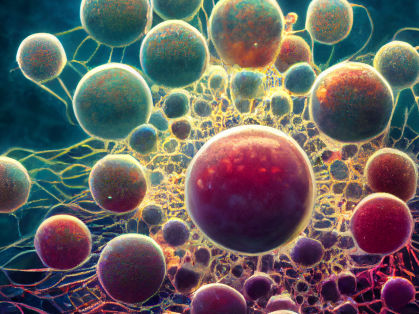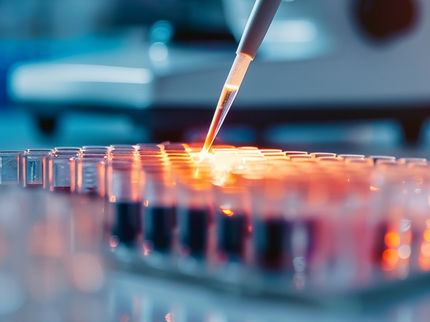How cells find the right partners
Researchers at the University of Freiburg find that affinity between cells can control complex developmental processes
Advertisement
During the growth and development of living organisms, different cell types must come into contact with each other in order to jointly form tissue and organs. A small team led by Prof. Dr. Anne Classen from the Cluster of Excellence CIBSS - Centre for Integrative Biological Signalling Studies at the University of Freiburg has now discovered that complex shape changes during development are controlled exclusively by the affinity of cells for each other. The researchers studied egg chambers of fruit flies(Drosophila melanogaster) and combined genetic methods with mathematical modeling. The study was published in the journal Nature Communications.

Symbol image
Computer-generated image
Complex organizational processes in the egg chamber
"We wanted to find out how different cell types organize with each other to form functional units," said Dr. Vanessa Weichselberger, first author of the study and a member of Classen's lab, summarizing the goal of their research. "The egg chamber is a good example of this, because in it, different cell populations must come together according to their function." The egg chamber is the structure in which an egg matures until it is ready for fertilization. In Drosophila, it resembles a tiny football: inside lies the growing egg on one side and 15 nurse cells on the other, which supply the egg with nutrients. In order to produce an egg, the egg cell must mature, while the nurse cells are eventually degraded.
Both processes, the maturation of the egg and the degradation of the nurse cells, depend on an outer layer of epithelial cells. For this purpose, the epithelial cells are divided into specialized groups which, due to their function, must be in contact with either the nurse cells or the oocyte. This partner-finding between the inner and outer cells is a complex process that takes place while at the same time the size ratios inside are constantly changing. "What mechanisms can robustly control such a dynamic process was previously unknown," Classen says.
Eya controls cell cohesion
The researchers had observed that epithelial cells, which specialize in breaking down nurse cells, spread out and flatten on top of them. In doing so, they form a particularly large contact area with the cells below. "This could be explained by an increased affinity between the two cell types," Weichselberger explains. "We therefore hypothesized that mate-finding could be explained by simple mechanical attraction or repulsion processes." Increased affinity from a specialized part of the epithelial cells to the nurse cells would then lead to the remaining epithelial cells being displaced by the nurse cells and coming into contact with the egg. The researchers found that Eya, a protein that can control the activity of genes, affects the contact behavior between the epithelial and nurse cells. If the researchers increased the concentration of Eya in epithelial cells, they increased their contact area with nurse cells; if they turned Eya off, the contact area minimized.
The affinity of cells is crucial for development
To test their hypothesis, the developmental biologists used mathematical modeling. To do this, they collaborated with Prof. Dr. Patrick Dondl from the Faculty of Mathematics and Physics at the University of Freiburg. Dondl created computer models in which varying degrees of mechanical affinity between cells could be simulated. "Through the mathematical modeling, we were able to show that a change in affinity depending on Eya levels is sufficient to control the complex process of partner finding," Weichselberger explains. "This meant that we could use Eya as a set screw to genetically control mate finding."
"Extremely flexible and robust"
By genetically altering Eya concentrations in epithelial cells and simulating these experiments in parallel on a computer, the researchers were able to test whether Eya-regulated affinity between epithelial cells and nurse cells is responsible for mate finding. They found that by manipulating Eya alone, it was possible to specifically control which epithelial cells spread to the nurse cells and which epithelial cells came into contact with the egg. This showed that Eya, by regulating affinity, is the main regulator of partner finding between epithelial cells and nurse cells and oocyte, respectively. This also surprised Classen, who led the study: "Specific affinity is indeed sufficient as a mechanism to control such complex developmental processes. And it does so extremely flexibly and robustly, independent of the volume of the egg chamber."
Similar processes in the male
This mechanism is not exclusive to the egg chamber: Sperm development in the Drosophila male is also dependent on Eya, which also controls affinity between inner sperm cells and outer epithelial cells. Whether the results can be applied to other animals or humans is unclear. But the comparable structure and development of the egg chamber in other species makes this seem possible.
Note: This article has been translated using a computer system without human intervention. LUMITOS offers these automatic translations to present a wider range of current news. Since this article has been translated with automatic translation, it is possible that it contains errors in vocabulary, syntax or grammar. The original article in German can be found here.



























































